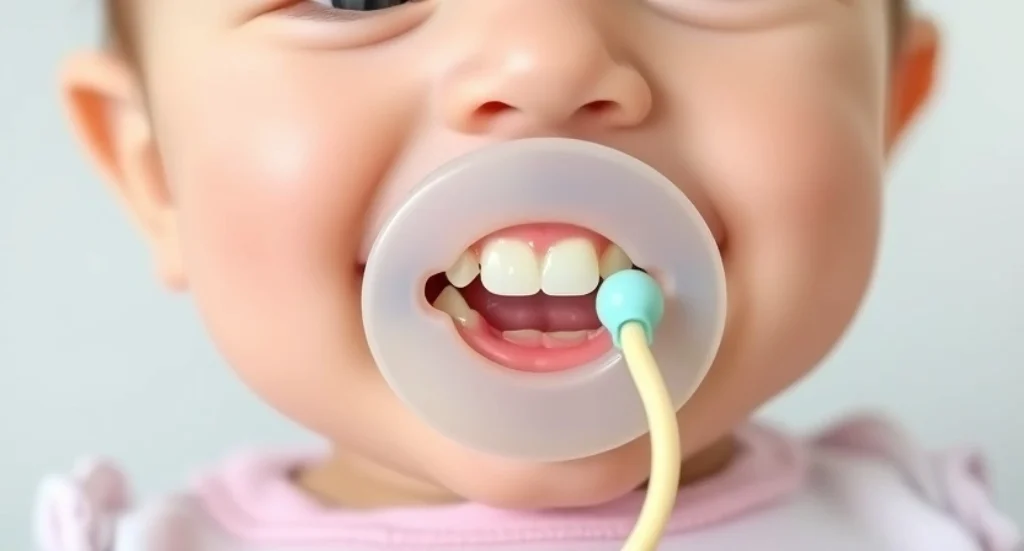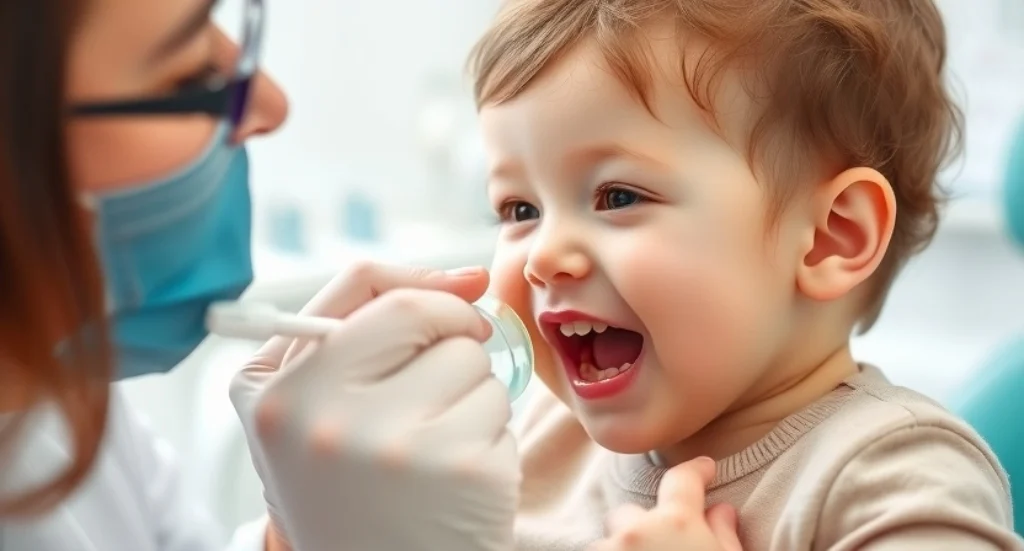Pacifiers can provide comfort to babies and toddlers, but extended use may lead to pacifier teeth problems. Issues like open bite, buck teeth, and crossbites can arise if pacifier use continues for too long.
The longer a child uses one, the higher the risk of needing orthodontic treatment later. Dentists typically recommend stopping pacifier use by age three to prevent these potential issues.
Key Takeaways
- Prolonged pacifier use can cause dental problems like open bite, buck teeth, and crossbites.
- Dentists recommend discouraging pacifier use after age three to reduce the need for future orthodontic treatment.
- Pacifier teeth issues are often reversible if the habit is stopped by 24-48 months.
- Alternative soothing methods like breastfeeding and natural teething toys can help prevent pacifier dental problems.
- Consulting a pediatric dentist or orthodontist is advised if concerned about a child’s pacifier habits or dental issues.
The Pacifier Dilemma: Soothing or Damaging?
As a parent, dealing with pacifiers is tricky. You want to soothe your baby but also protect their teeth. Pacifiers can calm and comfort, but they also have risks.
Pacifiers as a Double-Edged Sword
Using pacifiers for too long can harm teeth. It can cause misaligned bites and cavities. If you dip the pacifier in sweet stuff, it’s even worse.
But, pacifiers aren’t all bad. They help babies relax and can even lower SIDS risk. The trick is to find the right time to stop using them.
- Thumb sucking is most prevalent between the ages of 2 and 4.
- It is generally recommended to wean a child off the pacifier between six months and one year to avoid potential negative impacts on oral development.
- Awareness of the potential harmful effects of thumb sucking and prolonged pacifier use is crucial for parents to foster positive oral health habits in children.
- Early intervention is essential in addressing concerns related to misalignment of teeth and orthodontic issues caused by thumb sucking and extended pacifier use.
Choosing to use a pacifier and for how long is complex. It’s about weighing the good and bad sides. Like with parenting, finding the right balance and watching out for dental health is vital for your child’s health.
Pacifier Teeth: What Are the Risks?
Parents often use pacifiers to soothe their babies. But, using them too long can harm your child’s teeth. Issues like misaligned bites, gum problems, and cavities can occur.
Using pacifiers can lead to misaligned teeth. Kids who use them past 4 years old are more likely to have dental problems. This is compared to those who stop earlier.
Pacifiers can also cause gum recession and cavities. If the pacifier is sweet, it’s even worse. This can hurt your child’s smile and oral health.
The American Academy of Pediatric Dentistry says to stop pacifiers by 3 years old. The American Academy of Pediatrics and the American Academy of Family Physicians suggest weaning by 6 months to 1 year. This is to avoid dental and ear problems.
While pacifiers help in the short term, their long-term effects are serious. Knowing the risks and weaning your child early can protect their smile. This ensures a healthy smile for years.
| Potential Pacifier Teeth Risks | Recommended Weaning Timeline |
|---|---|
| Misaligned bites (crossbites, open bites, etc.) Gingival recession Cavities | 6 months to 1 year of age (American Academy of Pediatrics and American Academy of Family Physicians) Discourage use after 3 years of age (American Academy of Pediatric Dentistry) |

Pacifier or Thumb: Which is Better?
As parents, we often debate the pros and cons of pacifiers versus thumb sucking for our kids. Both can offer comfort and soothe, but they can also affect dental health. Let’s look at which might be the better choice.
Research shows that long-term pacifier use can increase ear infection risk in infants. Thumb sucking, however, can cause dental problems like open bites and speech issues. Both habits can lead to dental issues if not stopped early, but pacifiers are often easier to stop using than thumbs.
The American Academy of Pediatric Dentistry suggests stopping thumb sucking and pacifier use by age 2 to avoid dental problems. If a child continues thumb sucking past 2, seeing a pediatric dentist is advised for guidance and possible interventions.
About 90% of infants start sucking their thumbs or fingers within two hours of birth. Most stop sucking by age 2 or 4. Parents should limit pacifier use and discourage thumb sucking by age 4, as permanent teeth start growing at 6.
We’ve seen the effects of pacifier and thumb sucking on dental health for over 40 years. While both offer comfort, stopping a pacifier habit is generally easier than breaking a thumb sucking habit. The American Academy of Pediatric Dentistry suggests pacifiers over thumbs for better dental health.

| Pacifier | Thumb Sucking |
|---|---|
| Increased risk of ear infections | Dental misalignments, open bites, speech problems |
| Easier to wean off | Harder to break the habit |
| Recommended by the American Academy of Pediatric Dentistry | Not preferred over pacifier use |
Orthodontic Pacifiers: A Solution or a Myth?
As parents, we’re always looking for ways to soothe and support our kids’ growth. Pacifiers, especially “orthodontic” ones, seem appealing for dental health. But are they really a game-changer?
Exploring the Claims of Orthodontic Pacifiers
Orthodontic pacifiers have a flatter, more rounded shape. They aim to help with jaw development and alignment. But, is this really true?
These pacifiers might seem like a good choice, but the science is mixed. A study in the Journal of the American Dental Association found that long-term pacifier use can lead to dental misalignment, not just the shape of the pacifier. It’s the length of time using a pacifier that matters, not its design.
Remember, even orthodontic pacifiers should be used with care and stopped by age two to avoid dental problems. The length of use, not the shape, affects your child’s teeth.
- Pacifiers are good for babies under 2 as they help without harming teeth or development.
- Children over 2 who still use pacifiers may face dental issues and other problems.
- Start weaning a child off a pacifier by their first birthday to ease the transition.
| Pacifier Type | Recommendation |
|---|---|
| Latex Pacifiers | Avoid due to risk of latex allergies and potential for babies biting through them |
| Silicone Pacifiers | Preferred over latex |
| Plastic Shield Pacifiers | Common, with no significant difference between colors and shapes as long as the shield has holes to prevent choking |
Orthodontic pacifiers might seem like a good idea, but the real key is responsible use and weaning on time. Following pediatric advice can help keep your child’s smile healthy and bright.
Best Pacifiers for Teething Relief: Top 3 Picks for Your Baby
Teething can be a challenging time for both babies and parents. The discomfort and irritability caused by emerging teeth can disrupt your little one’s peace and leave you searching for a solution. Thankfully, teething pacifiers are here to help! These innovative products combine soothing features with the safety of high-quality materials to provide gentle relief for your baby.
In this post, we’ll explore three exceptional teething pacifiers available on Amazon that offer comfort, convenience, and safety. Designed with thoughtful features like cooling effects, soft silicone textures, and even feeding options, these pacifiers are must-haves for teething babies.
Let’s dive into the details of these products to help you make the best choice for your little one!
Nippii Freezable Teether Pacifier for the ultimate teething relief! Cools up to 30 minutes. Leak-free design. 100% medical-grade silicone. Dishwasher safe.
NatureBond Baby Fruit Feeder is both a fruit feeder and teething toy. It can store fresh or frozen fruits, vegetables and ice chips.
Tiny tastes, Fresh Firsts! Safely introduce baby to new food with Dr Brown's Fresh Firsts Silicone Feeder. In stock. Quantity.
1. Freezable Pacifier for Teething
- Key Features:
- Medical-grade BPA-free silicone ensures safety for your baby.
- Cooling effect provides instant relief for sore gums.
- Designed for babies aged 0-9 months, making it perfect for early teething stages.
- Why We Love It:
The freezable feature sets this pacifier apart, offering quick and effective relief for teething discomfort. Plus, its easy-to-clean design makes it a win for busy parents!
2. NatureBond Baby Food Feeder/Fruit Feeder Pacifier Nibbler (2 Pack)
- Key Features:
- Dual functionality as a food feeder and teething pacifier.
- Comes with additional silicone sacs for versatile use.
- Vibrant, appetizing colors to engage your baby.
- Why We Love It:
This product not only soothes teething pain but also encourages healthy eating habits, making it a multi-purpose solution for babies.
3. Dr. Brown’s Fresh First Silicone Feeder
- Key Features:
- Made from soft, baby-safe silicone to protect delicate gums.
- Compact design suitable for little hands to grasp.
- Includes two feeders in stylish mint and grey colors.
- Why We Love It:
Dr. Brown’s feeder is an excellent choice for parents looking for a simple, mess-free way to ease teething pain while introducing new flavors to their baby.
Conclusion
Pacifiers can soothe and comfort babies, but they can also harm their teeth if used too long. Issues like misaligned bites and protruding teeth can happen if a child uses a pacifier past 3 years old. It’s important to stop using a pacifier by this age to avoid pacifier teeth and promote healthy teeth.
Parents can prevent dental problems by weaning their child off the pacifier habit early. Working with a pediatric dentist is key. Regular dental visits help track a child’s dental health and catch any problems early.
Using a pacifier responsibly and keeping it clean can also help. This way, you can lower the risk of dental issues linked to long-term use.
The goal is to start weaning children off pacifiers by 12 months. By 4 years old, they should stop using them. This helps avoid “pacifier teeth” and other dental problems. With the right steps and support, kids can grow up with a healthy, beautiful smile.
FAQ
How can pacifiers impact a child’s dental health?
Many babies and toddlers use pacifiers to calm down. But, using them too long can harm their teeth. Issues like open bite and buck teeth might occur. Dentists say to stop using pacifiers by age three to avoid these problems.
What are the potential drawbacks of using pacifiers?
Pacifiers can soothe babies, but they have dental risks. They can cause misaligned bites and other dental problems. If dipped in sweet stuff, they can also lead to cavities and gum recession.
What are the main dental issues associated with prolonged pacifier use?
Prolonged use of pacifiers can lead to misaligned bites. Children who use them past 4 years are more likely to have dental issues. They can also cause gum recession and cavities, especially if sweetened.
How do pacifiers compare to thumb sucking in terms of dental impact?
Pacifiers and thumb sucking can both cause dental problems. But, it’s easier to stop using pacifiers. Thumb sucking can be harder to break, especially at night. The American Academy of Pediatric Dentistry suggests pacifiers over thumb sucking.
Do orthodontic pacifiers really prevent dental issues?
Orthodontic pacifiers are made to help with jaw alignment. But, they don’t guarantee prevention of dental problems. It’s still key to stop using pacifiers by age 3 to avoid dental issues.
Prices are accurate at the time of publication and may change.
Don’t miss out. Explore our Daily Deals for the hottest picks right now. Want more? Sign up for the Best Price Goods weekly newsletter to unlock shopping inspiration and exclusive deals on your favorite brands!
Author
-
Priscilla, a devoted mother of two, combines her parenting experience with writing for Best Price Goods. She expertly researches and shares insights on products that enrich the lives of children at all ages.
View all posts









